When flying UAVs as a tourist photographer, prioritize safety and legality. Know local drone laws, check weather conditions, and maintain visual line of sight. Respect no-fly zones and avoid crowds. Use proper takeoff and landing procedures. Be mindful of wildlife and keep a safe distance. Carry all necessary documentation, including registration and permits. Manage your batteries wisely and evaluate insurance options. Always prioritize safety over getting the perfect shot. Remember to respect privacy and local customs when capturing images. These essential tips will help you navigate the complexities of drone photography while traveling, but there's much more to evaluate for a truly successful experience.
Know Local Drone Laws
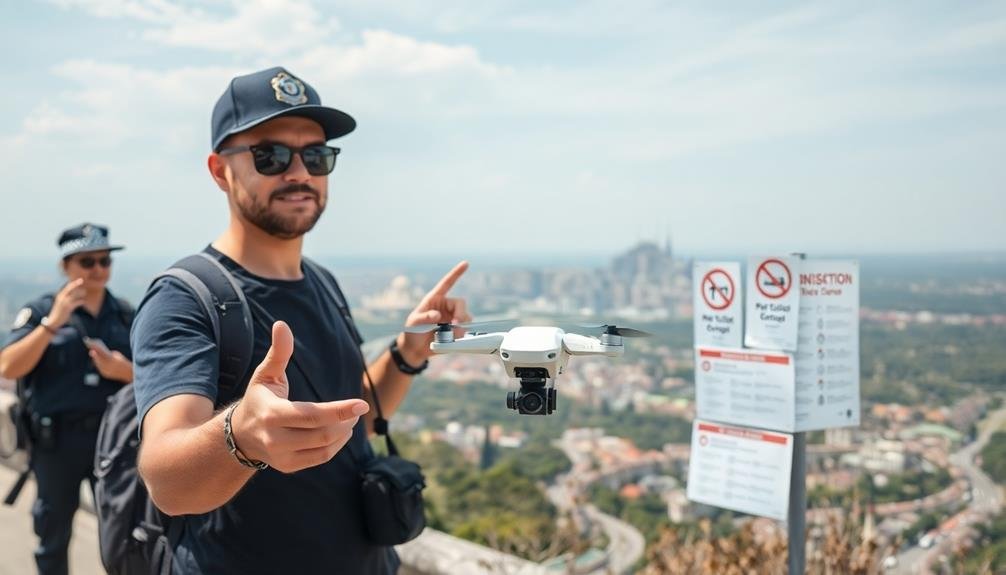
Three essential steps for tourists flying drones: research, comply, and stay informed.
Before you even pack your drone, investigate the drone laws of your destination. Many countries have strict regulations on UAV usage, and some even ban them entirely. Check official government websites or consult with local authorities to understand the specific rules.
Once you've researched, make sure you comply with all requirements. This may include registering your drone, obtaining permits, or passing a knowledge test. Don't assume your home country's certification will suffice abroad. Some nations require you to have insurance for your drone operations.
Stay informed about no-fly zones, which often include airports, military installations, and government buildings. Many tourist attractions and national parks also restrict drone usage. Use apps like B4UFLY or UAV Forecast to check for flight restrictions in real-time.
Be aware of privacy laws, too. In some places, it's illegal to capture images of people or private property without consent.
Respect local customs and cultural sensitivities regarding photography and privacy. By thoroughly understanding and following local drone laws, you'll avoid legal troubles and enjoy a safer, more responsible flying experience.
Check Weather Conditions
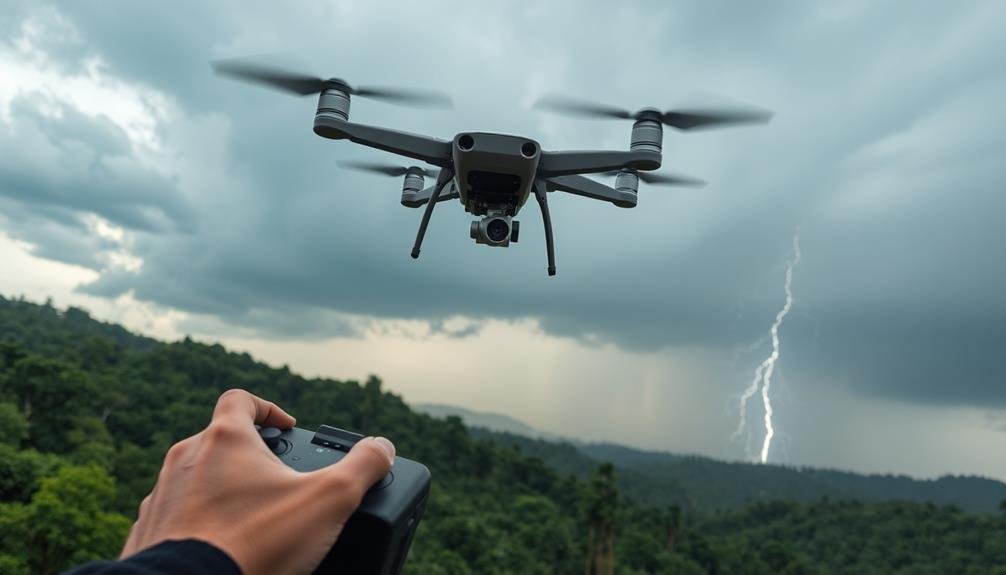
Before you take off, always check the current and forecasted weather conditions.
Pay close attention to wind speed and direction, as strong gusts can affect your drone's stability and flight path.
Don't forget to contemplate visibility and precipitation, which can impact both your ability to maintain visual contact with your UAV and the drone's performance in the air.
Wind Speed and Direction
Wind conditions play an essential role in safe UAV operation for tourist photographers. You'll need to assess both wind speed and direction before launching your drone. Strong winds can compromise your UAV's stability, battery life, and ability to return home safely. Always check local weather forecasts and use on-site wind measurement tools to make informed decisions.
When evaluating wind conditions, consider these key factors:
- Wind speed at ground level vs. higher altitudes
- Gusty or steady wind patterns
- Wind direction in relation to your flight path
- Potential wind tunnels created by buildings or terrain
- Sudden changes in wind direction or speed
As a general rule, avoid flying in winds exceeding 20 mph (32 km/h) for most consumer drones. However, consult your specific UAV's manual for its wind resistance capabilities.
Remember that wind speed typically increases with altitude, so what feels manageable on the ground may be dangerous at higher elevations.
If you're flying in coastal areas, be aware of sea breezes and their patterns throughout the day. In mountainous regions, watch for unpredictable updrafts and downdrafts.
Visibility and Precipitation
Alongside wind conditions, visibility and precipitation are key weather factors to assess before flying your drone. Visibility affects your ability to maintain visual line of sight with your UAV, which is vital for safe operation. Check local weather reports for visibility distance and be aware of any fog, haze, or smoke that might impair your view.
Precipitation can damage your drone's electronics and affect its stability in flight. Avoid flying in rain, snow, or sleet, as moisture can seep into the device and cause malfunctions. Even light drizzle can interfere with sensors and camera lenses, compromising image quality and flight performance.
Keep an eye on cloud cover, as low clouds can limit your drone's altitude and operational range. Bright sunlight can also create glare on your controller's screen, making it difficult to see important flight data and camera feed.
Before takeoff, assess the overall weather conditions. If visibility is poor or precipitation is likely, postpone your flight.
Maintain Visual Line of Sight

One of the most essential rules for flying UAVs is maintaining visual line of sight. This means you must always be able to see your drone with your naked eye, without relying on cameras or other devices. It's not just a recommendation; it's often a legal requirement in many countries.
Keeping your drone in sight helps you:
- Avoid collisions with obstacles or other aircraft
- Monitor your drone's behavior and performance
- React quickly to unexpected situations
- Comply with local regulations
- Guarantee you're flying within permitted areas
Don't let your drone fly too far away or behind obstacles that block your view. If you lose sight of your UAV, land it immediately using your controller's return-to-home function. Remember, first-person view (FPV) goggles or your drone's camera feed don't count as maintaining visual line of sight.
In unfamiliar areas, scout your surroundings before takeoff to identify potential hazards or no-fly zones. Always be aware of your drone's position relative to you and any nearby obstacles.
If you're flying in a group, designate a spotter to help maintain visual contact with the drone at all times.
Respect No-Fly Zones

Awareness of no-fly zones is essential for responsible drone operation. As a tourist photographer, you must research and respect these restricted areas before flying your UAV. No-fly zones often include airports, military bases, government buildings, and national parks.
Many countries have specific regulations regarding drone use, so it's important to familiarize yourself with local laws before traveling.
Use official apps and websites to check for no-fly zones in your intended flight area. These resources are regularly updated and provide accurate information on restricted airspace.
Don't rely solely on your drone's built-in geofencing, as it may not always be up-to-date or thorough.
Be aware that temporary no-fly zones can be established for events, emergencies, or security reasons. Stay informed about current restrictions in your area.
If you're unsure about a location's status, err on the side of caution and don't fly.
Violating no-fly zones can result in severe penalties, including fines, confiscation of your equipment, and even legal action.
It's not worth risking your safety, legal standing, or the reputation of responsible drone operators for a photo opportunity. Always prioritize safety and compliance over getting the perfect shot.
Avoid Crowds and People
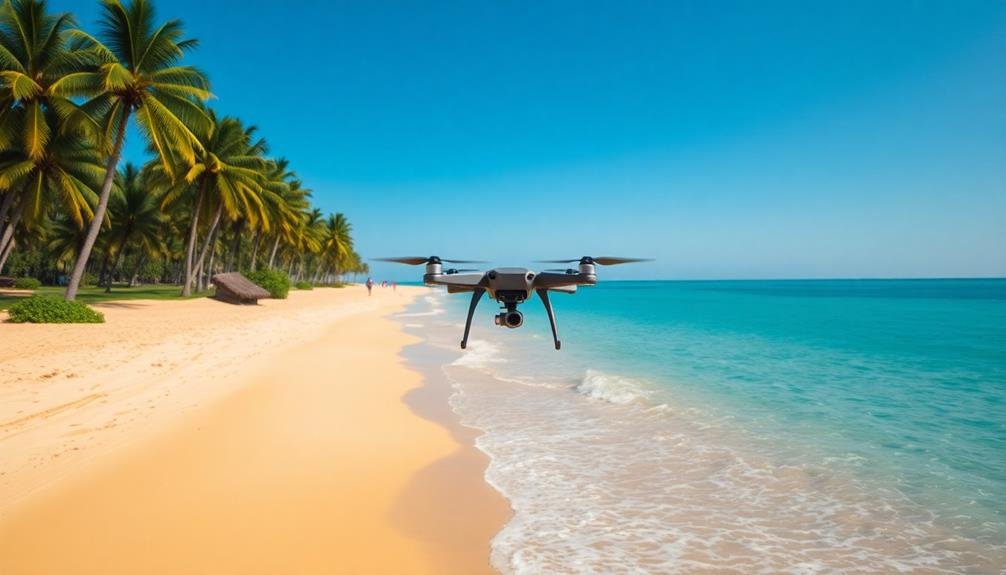
When flying your UAV, you'll need to be mindful of privacy laws and avoid capturing images of people without their consent.
Keep your drone at a safe distance from individuals and crowds to prevent accidents and alleviate concerns.
If you're planning to photograph in areas where people are present, it's best to seek permission first and explain your intentions clearly.
Respect Privacy Laws
Many countries have strict privacy laws that apply to aerial photography, making it essential for tourist photographers to understand and respect these regulations. Before flying your UAV, research local laws regarding aerial photography and privacy. You'll need to be aware of restrictions on capturing images of private property, individuals, or sensitive areas.
To respect privacy laws while flying your drone:
- Always obtain permission before photographing people or private property
- Avoid flying over residential areas without explicit consent
- Be cautious when capturing images near government buildings or military installations
- Don't share or publish photos that could infringe on someone's privacy
- Delete any inadvertently captured sensitive images immediately
Remember that privacy laws can vary greatly between countries and even regions within a country. What's legal in your home country may be strictly prohibited elsewhere.
If you're unsure about local regulations, err on the side of caution and refrain from flying your UAV. Additionally, be prepared to show authorities your flight permissions and explain your intentions if questioned.
Maintain Safe Distances
Maintaining safe distances from people and crowds is a key aspect of responsible UAV operation. When flying your drone as a tourist photographer, you must prioritize the safety of those around you. Always keep your UAV at least 30 meters (100 feet) away from individuals and groups. This buffer zone helps prevent accidents and reduces the risk of injury from falling drones or spinning propellers.
Be extra cautious in populated areas or tourist hotspots. Don't fly over crowds, public gatherings, or sporting events without proper authorization. If you're capturing footage of a busy location, consider flying during off-peak hours when fewer people are present.
Always maintain visual line of sight with your drone and be prepared to land immediately if people approach your flight path.
Remember that different countries have varying regulations regarding minimum distances for drone operations. Research and adhere to local laws before flying. In some cases, you may need to obtain special permits or permissions to fly near populated areas.
Seek Permission First
Seeking permission before flying your drone is essential for responsible and legal UAV operation. As a tourist photographer, you're likely unfamiliar with local regulations, making it vital to research and obtain necessary approvals.
Check with local authorities, park rangers, or property owners before launching your UAV. Many popular tourist destinations have specific rules or restrictions on drone use.
Don't assume it's okay to fly just because you see others doing so. Always err on the side of caution and seek explicit permission. This approach not only keeps you compliant with laws but also shows respect for local customs and privacy concerns.
Here are key points to remember when seeking permission:
- Research local drone laws and regulations before your trip
- Contact relevant authorities or property owners in advance
- Carry documentation of any permissions you've obtained
- Be prepared to explain your intentions and equipment
- Respect decisions if permission is denied
Keep Batteries Charged

A drone's worst enemy is a dead battery. When you're traveling and using your UAV for photography, you can't afford to run out of power mid-flight. Always start your day with fully charged batteries and bring spares. Most consumer drones have a flight time of 20-30 minutes, so plan accordingly.
Invest in a portable charger or power bank that's compatible with your drone's batteries. This will allow you to recharge in the field if needed. Be aware of how temperature affects battery performance. Cold weather can greatly reduce flight time, so keep batteries warm before use.
Monitor your battery levels closely during flight. Set a "return to home" threshold that gives you enough power to safely land. Don't push your luck by flying too far or too long.
When storing batteries, keep them at about 50% charge. Fully discharged or overcharged batteries can degrade over time. If you're not using your drone for an extended period, check and recharge batteries every few months.
Proper battery management isn't just about convenience; it's a vital safety measure. A sudden power loss can lead to crashes, property damage, or injuries.
Use Proper Takeoff Procedures

While it may be tempting to rush into flight, using proper takeoff procedures is essential for safe drone operation. Before lifting off, verify you're in a clear area free from obstacles and people. Check your surroundings for potential hazards like power lines, trees, or buildings.
Always perform a pre-flight checklist, including inspecting your drone's propellers, frame, and camera mount for any damage or loose parts.
When you're ready for takeoff, follow these steps:
- Place your drone on a flat, stable surface
- Power on your remote controller first, then the drone
- Wait for the GPS signal to lock and home point to be set
- Calibrate the compass if prompted or if you've changed locations
- Start the motors and lift off slowly, hovering a few feet above ground
As you ascend, keep an eye on your drone's behavior. If you notice any instability or unusual sounds, land immediately.
Remember to maintain visual line of sight with your drone at all times during flight. By following these proper takeoff procedures, you'll greatly reduce the risk of accidents and verify a safer flying experience for yourself and those around you.
Practice Safe Landing Techniques

Bringing your drone down safely is just as essential as getting it airborne. When it's time to land, follow these vital steps to protect your UAV and those around you.
First, choose a clear, level landing area free of obstacles, people, and animals. Slowly descend your drone, maintaining a steady hover about 10-15 feet above the ground. As you approach the landing spot, reduce your speed and altitude gradually.
Keep an eye on your battery levels and initiate landing procedures before they become critically low. If your drone has an automatic return-to-home feature, familiarize yourself with how it works and when it activates.
When you're about 3-5 feet from the ground, cut the throttle to allow for a gentle touchdown. Don't try to catch the drone mid-air; let it land completely before approaching.
After landing, immediately turn off the motors to prevent any accidental movement. If you're landing on uneven terrain, use the drone's legs or landing gear for stability.
In windy conditions, approach your landing from the direction of the wind to maintain better control. Always prioritize safety over getting the perfect shot, and be prepared to abort the landing if unexpected obstacles or conditions arise.
Be Mindful of Wildlife
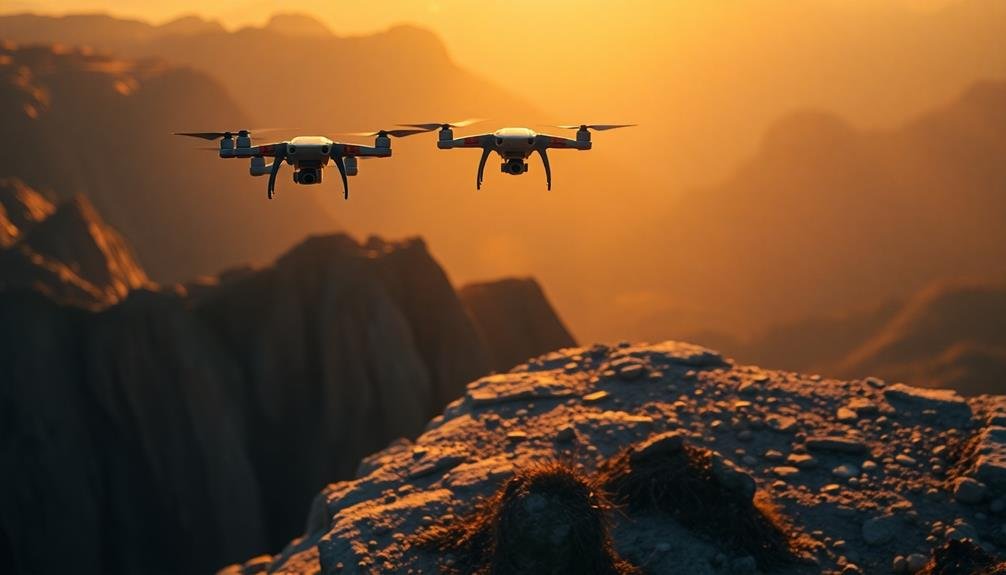
Safe landings are important, but responsible drone operators must also consider their impact on local ecosystems. When flying your UAV in natural areas, you're entering the habitat of various wildlife species. Your drone's presence can cause stress, disrupt feeding patterns, and even lead to nest abandonment in birds.
To minimize your impact, always research the area's wildlife before flying and adhere to local regulations. Be especially cautious during breeding seasons and in sensitive habitats. Keep your drone at a safe distance from animals, and if you notice signs of distress, such as birds circling or animals fleeing, immediately retreat.
Remember, getting the perfect shot isn't worth harming wildlife or their habitats.
Here are some key points to keep in mind:
- Maintain a minimum distance of 100 meters from wildlife
- Avoid flying near nesting sites or animal dens
- Don't chase or harass animals with your drone
- Use quiet propellers to reduce noise disturbance
- Learn to recognize signs of animal distress
Carry Necessary Documentation
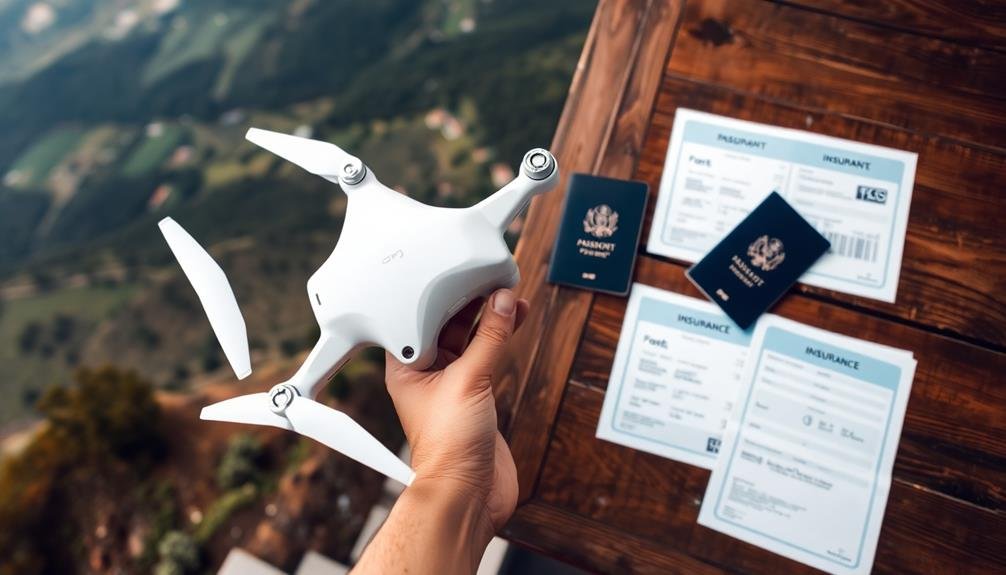
When flying your drone as a tourist photographer, you'll need to carry specific documentation.
Make certain you have all required permits and licenses for operating a UAV in the area you're visiting.
Don't forget to bring your drone registration paperwork, as authorities may request to see it at any time.
Required Permits and Licenses
The legal landscape for UAV operation can be complex and varies by location. As a tourist photographer, you'll need to research and obtain the necessary permits and licenses before flying your UAV in a foreign country.
Many nations require specific certifications for commercial drone use, even if you're just capturing personal memories. Don't assume your home country's license will suffice abroad.
To guarantee you're compliant with local regulations, consider these key points:
- Check the destination country's aviation authority website for up-to-date UAV rules
- Determine if you need a temporary visitor's permit for recreational drone use
- Verify if there are restrictions on importing drones through customs
- Inquire about special permissions for flying in sensitive areas or near landmarks
- Confirm if you need to register your drone with local authorities upon arrival
Drone Registration Paperwork
Nearly all countries require drone operators to carry specific documentation while flying. You'll need to have your drone registration paperwork readily available at all times. This typically includes your drone's unique registration number and proof of registration.
Keep these documents in a waterproof, easily accessible container or folder.
In addition to registration paperwork, you should carry your pilot's license or certification if required by local regulations. Some countries may also mandate that you have proof of insurance for your drone operations.
It's essential to research and obtain all necessary documentation before your trip.
Don't forget to bring your drone's manual and any additional permits specific to the areas you plan to fly in. Many tourist destinations have restricted zones or require special authorization for drone use.
Having all relevant paperwork on hand can save you from potential fines or confiscation of your equipment.
Always keep digital copies of your documents stored securely online or on your smartphone as a backup. This precaution can be invaluable if you misplace your physical copies or encounter unexpected checks by local authorities.
Frequently Asked Questions
What's the Best Drone for Beginner Tourist Photographers?
You'll want a beginner-friendly drone that's easy to fly and takes great photos. Consider the DJI Mini 2 or Mavic Air 2. They're lightweight, have good battery life, and offer excellent image quality for your tourist photography adventures.
How Can I Protect My Drone From Theft While Traveling?
You'll want to secure your drone when not in use. Keep it in a locked, inconspicuous bag. Don't leave it unattended. Use GPS tracking if available. Consider travel insurance. Always be aware of your surroundings when flying.
Are There Special Considerations for Flying Drones Near Water Bodies?
You'll need to be extra cautious when flying near water. Watch out for reflections affecting your visuals, avoid saltwater spray damaging electronics, and be prepared for sudden wind gusts. Always maintain a safe distance from the water's surface.
What Should I Do if My Drone Loses Connection Mid-Flight?
If your drone loses connection, don't panic. Wait briefly for it to reconnect. If it doesn't, activate the "return to home" function. Keep your controller on and maintain visual contact. Be prepared to manually land if necessary.
How Can I Safely Transport Lithium Batteries for My Drone?
You'll want to transport your drone's lithium batteries in your carry-on luggage. Keep them in protective cases, make certain they're not fully charged, and cover the terminals. Don't pack them in checked bags due to safety regulations.
In Summary
You've now got the essential safety tips for flying your drone as a tourist photographer. Remember, safety should always be your top priority. By following these guidelines, you'll protect yourself, others, and your equipment while capturing stunning aerial shots. Stay informed, be responsible, and enjoy your drone photography adventures. Don't forget to share your breathtaking images with fellow enthusiasts, but always put safety first. Happy flying!

As educators and advocates for responsible drone use, we’re committed to sharing our knowledge and expertise with aspiring aerial photographers.




Leave a Reply